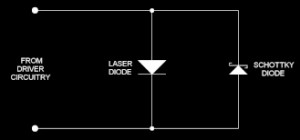ESD polarity terminology used on this web site
The term “positive-ESD” is used to mean electrostatic discharge (ESD) whose voltage polarity would tend to forward-bias a laser diode. “Negative-ESD,” means ESD whose voltage polarity would tend to reverse-bias a laser diode.
|
Review of ESD approaches |
||||
| START | PREV | CURRENT | NEXT | END |
|
Introduction << |
||||
Review of ESD approaches
Schottky diode used as an ESD protection means
 Schottky diode circuit used for ESD protection. The figure to the right shows another ESD protection means commonly employed to protect laser diodes. In this scheme, a Schottky diode is connected anti-parallel with the laser diode. However, there are several problems with this technique.
Schottky diode circuit used for ESD protection. The figure to the right shows another ESD protection means commonly employed to protect laser diodes. In this scheme, a Schottky diode is connected anti-parallel with the laser diode. However, there are several problems with this technique.
First of all, most Schottky diodes were not designed to handle nanosecond pulses of up to 50 amps. Within our testing using the human body model, many Schottky diodes were themselves destroyed by an ESD event of as little as 800 volts. Therefore, if the device that is put in place as the ESD protection means is destroyed by the ESD event, this is deemed to be an ineffective ESD protection means.
Second, and more important, such a configuration would only protect the laser diode from negative-ESD events (i.e., those events that would tend to reverse-bias the laser diode). Positive-ESD events are allowed to pass through to the laser diode without being attenuated by a Schottky diode. Thus, at best, a Schottky diode is an incomplete ESD protection means.

